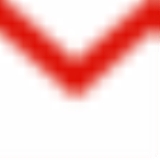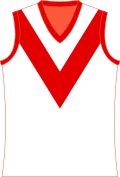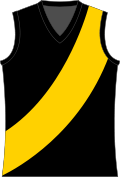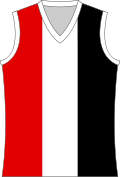
North Coast Australian Football League
Encyclopedia
The North Coast Australian Football League (also known as AFL North Coast) is an Australian rules football
competition in the Mid North Coast region of New South Wales
.
The club did not have enough players for a team, or a coach, nor a ground to play on yet they commenced training at 5pm on Tuesdays in December at the St Augustine’s school oval such was their enthusiasm for the game. The new club chose to adopt the colours of North Melbourne Football Club
, at that time enjoying great success in the then VFL
, while the Dehnert brothers, Noel and Phil volunteered to provide timber saplings for the goal posts.
Some club scratch matches were played that year but the match at Coffs Harbour racecourse was the only official match played in Coffs in 1977.
A North Coast team made of players from Coffs Harbour and Port Macquarie played in the Northern NSW Country Championships at Gunnedah in May of 1977 but lost both matches to New England and a North-West team. It was decided at these championships to play the 1978 series at Coffs Harbour to promote the game on the North Coast.
for the 1978 season. The competition had four teams based around the New England university and Uralla who had also entered the New England competition that year. There were two major challenges for the Coffs Harbour club now that it had a competition to play in. The first hurdle to overcome was to secure a ground to train and play on. The second issue was to travel for away games across to Armidale almost 180 kilometres away via Dorrigo Mountain with a large unsealed section of road at Ebor. The club was very fortunate to have as a Mike Cain as a committee member as he was working at the time as a town planner with the Coffs Harbour Shire Council. It was largely through his efforts that the club secured England’s Park as a home ground.
Coffs Harbour enjoyed almost immediate success in this league finishing third in its initial season in the New England league then taking out the premiership in 1979.
Therefore, it entered two teams in the New England AFL in 1980 – Souths and Norths, but under the one administration with a view to eventually forming a North Coast league.
Brian Saville said in the Coffs Coast Advocate on October 5, 1979: “Having a strong side for a long time will not benefit the sport in this area”. He added that the aim of the Coffs Harbour club was to have its own North Coast League.
As the original Coffs club had worn blue and white vertical stripes the same as VFL club North Melbourne (Kangaroos) it was agreed to call one team “Norths” and the other “Souths” based on the-then VFL club South Melbourne (now the Sydney Swans
) and have it wear white with a red V.
The first ever local derby between the North Coffs and South Coffs was played in 1980 on May 18 “in fine spirit before a large, enthusiastic crowd at England’s Park”. The final score saw North Coffs 10.5 (65) defeat South Coffs 9.10 (64).
North Coffs defeated Armidale City 13.8 (86) to 4.5 (29) for the 1980 New England AFL premiership after the Armidale team defeated South Coffs in the preliminary final. The next year North Coffs and South Coffs met in the 1981 grand final which South Coffs won.
The first year was medal weas awarded, North Coffs midfielder Greg Jarman edged out teammate Brad Giri for the award.
Teenager Jack Gillingham became the first player to be awarded two Jim Woodlock Medals when he won the coveted award in 2009 and 2010 when Sawtell-Toormina comfortably won the grand final.
At the end of the 2011 season, no player from a losing grand final team had won the award.
's Brownlow Medal
. The weekend after the grand final the grand final, a vote count is held to decide the recipient of the award. The player who has won the most League Best & Fairest awards is former Sawtell-Toormina ruckman Brian Rava whose strong marking helped him to win the three times in 1991, 1992 and 1998. Jeff Reed, Troy Mirkin, Brad Giri and Mark Couzens have all won the award twice. Mirkin is the only player to win the award at two different clubs. The list of League Best & Fairest winners follows:
Australian rules football
Australian rules football, officially known as Australian football, also called football, Aussie rules or footy is a sport played between two teams of 22 players on either...
competition in the Mid North Coast region of New South Wales
New South Wales
New South Wales is a state of :Australia, located in the east of the country. It is bordered by Queensland, Victoria and South Australia to the north, south and west respectively. To the east, the state is bordered by the Tasman Sea, which forms part of the Pacific Ocean. New South Wales...
.
The very beginning
A meeting to form an Australian Football club in Coffs Harbour was held in the Coffs Hotel on December 6, 1976. The meeting to form the Coffs Harbour club was attended by 12 enthusiastic people - all of whom were elected to the committee. Fred Miller, who had led the charge to establish the code in the district, was elected as President. The first Secretary-Treasurer was Brian Saville.The club did not have enough players for a team, or a coach, nor a ground to play on yet they commenced training at 5pm on Tuesdays in December at the St Augustine’s school oval such was their enthusiasm for the game. The new club chose to adopt the colours of North Melbourne Football Club
North Melbourne Football Club
The North Melbourne Football Club, nicknamed The Kangaroos, is the fourth oldest Australian rules football club in the Australian Football League and is one of the oldest sporting clubs in Australia and the world...
, at that time enjoying great success in the then VFL
VFL
VFL can refer to:Sport* Victorian Football League, an Australian rules football league formerly known as the Victorian Football Association prior to 1996....
, while the Dehnert brothers, Noel and Phil volunteered to provide timber saplings for the goal posts.
Early Days
The first-ever Australian football match played in Coffs Harbour was in 1977 between a University of New England team and Coffs Harbour March 12 at the Coffs Harbour Racecourse – the university side won the match 13.12 (80) to 4.13 (37). The Coffs Coast Advocate reported that the match attracted about 50 spectators and “despite the heavy conditions was enjoyed by everyone there”.Some club scratch matches were played that year but the match at Coffs Harbour racecourse was the only official match played in Coffs in 1977.
A North Coast team made of players from Coffs Harbour and Port Macquarie played in the Northern NSW Country Championships at Gunnedah in May of 1977 but lost both matches to New England and a North-West team. It was decided at these championships to play the 1978 series at Coffs Harbour to promote the game on the North Coast.
Playing in New England
The Coffs Harbour club joined the New England AFLNew England Australian Football League
The New England Australian Football League was an Australian rules football league based around the University of New England in Armidale, Australia. It was created by UNE students in 1962 and ran until 1985, when its remaining clubs moved to the North West AFL.One former NEAFL club, the New...
for the 1978 season. The competition had four teams based around the New England university and Uralla who had also entered the New England competition that year. There were two major challenges for the Coffs Harbour club now that it had a competition to play in. The first hurdle to overcome was to secure a ground to train and play on. The second issue was to travel for away games across to Armidale almost 180 kilometres away via Dorrigo Mountain with a large unsealed section of road at Ebor. The club was very fortunate to have as a Mike Cain as a committee member as he was working at the time as a town planner with the Coffs Harbour Shire Council. It was largely through his efforts that the club secured England’s Park as a home ground.
Coffs Harbour enjoyed almost immediate success in this league finishing third in its initial season in the New England league then taking out the premiership in 1979.
Two teams in Coffs Harbour
Even in its infancy the Coffs club administrators knew that the future for Australian Rules on the Coffs Coast was on the coast.Therefore, it entered two teams in the New England AFL in 1980 – Souths and Norths, but under the one administration with a view to eventually forming a North Coast league.
Brian Saville said in the Coffs Coast Advocate on October 5, 1979: “Having a strong side for a long time will not benefit the sport in this area”. He added that the aim of the Coffs Harbour club was to have its own North Coast League.
As the original Coffs club had worn blue and white vertical stripes the same as VFL club North Melbourne (Kangaroos) it was agreed to call one team “Norths” and the other “Souths” based on the-then VFL club South Melbourne (now the Sydney Swans
Sydney Swans
The Sydney Swans Football Club is an Australian rules football club which plays in the Australian Football League . The club is based in Sydney, New South Wales. The club, founded in 1874, was known as the South Melbourne Football Club until it relocated to Sydney in 1982 to become the Sydney...
) and have it wear white with a red V.
The first ever local derby between the North Coffs and South Coffs was played in 1980 on May 18 “in fine spirit before a large, enthusiastic crowd at England’s Park”. The final score saw North Coffs 10.5 (65) defeat South Coffs 9.10 (64).
North Coffs defeated Armidale City 13.8 (86) to 4.5 (29) for the 1980 New England AFL premiership after the Armidale team defeated South Coffs in the preliminary final. The next year North Coffs and South Coffs met in the 1981 grand final which South Coffs won.
1982 - North Coast league begins
The New England AFL had provided a competition for the Coffs Harbour teams but it was time to move on and develop a coastal league. With the formation of the North Coast AFL in 1982 the two Coffs Harbour teams became clubs in their own right. The other clubs to form the North Coast Australian Football League were Grafton, Urunga, Woolgoolga and Port Macquarie. The Port club had been formed in 1981 and played its first season in the New England AFL. The inaugural President was Brian Saville, who had been instrumental in the establishment of the game in Coffs Harbour. Woolgoolga won the first of its nine premierships in the North Coast AFL when it beat Port Macquarie in the first-ever grand final.Current
| Club | Moniker | Jumper | Years competed | Website |
|---|---|---|---|---|
| Coffs Harbour | Swans |  |
1982-1991, 1993- | Official Site |
| Grafton | Tigers |  |
1982-1995, 2002- | Official Site |
| Nambucca Valley | Lions | 1986-1989, 2005- | Official Site | |
| North Coffs | Kangaroos | 1982- | Official Site | |
| Port Macquarie | Magpies |  |
1982-1984, 1993- | Official Site |
| Sawtell-Toormina | Saints |  |
1987, 1991-2001, 2003- | Official Site |
Previous
| Club | Colours | Years competed |
|---|---|---|
| Armidale City | 1988 | |
| Kempsey | 1993 | |
| Taree Hornets | Black & Gold | 1998-2002 |
| Urunga | 1982-1985 (relocated to become Nambucca Valley) | |
| Woolgoolga Blues | Blue & White | 1982-2005 |
Umpires Association
- North Coast Australian Football League Umpires Association Official Site
Premierships
| Club | 1st Grade | Reserve Grade | Under 18s |
|---|---|---|---|
| Coffs Swans | 6 | 8 | 8 |
| North Coffs Kangaroos | 6 | 0 | 3 |
| Sawtell-Toormina Saints | 6 | 1 | 1 |
| Port Macquarie Magpies | 2 | 7 | 0 |
| Woolgoolga Blues | 9 | 3 | 2 |
| Nambucca Valley Lions | 0 | 0 | 1 |
| Taree Hornets | 0 | 0 | 1 |
| Grafton Tigers | 1 | 0 | 0 |
List of AFL North Coast grand finals
| Year | Premiers | Runners Up |
|---|---|---|
| 1982 | Woolgoolga 14.16 (100) | Port Macquarie 6.17 (53) |
| 1983 | Woolgoolga 18.18 (126) | South Coffs 6.10 (46) |
| 1984 | South Coffs 14.14 (98) | Woolgoolga 13.4 (82) |
| 1985 | Woolgoolga 11.8 (74) | North Coffs 7.7 (49) |
| 1986 | South Coffs 12.12 (84) | Woolgoolga 11.12 (78) |
| 1987 | Woolgoolga 18.8 (116) | South Coffs 10.18 (78) |
| 1988 | Woolgoolga 16.15 (111) | South Coffs 16.9 (105) |
| 1989 | South Coffs 13.8 (86) | Woolgoolga 8.6 (54) |
| 1990 | North Coffs 13.10 (88) | Woolgoolga 6.13 (49) |
| 1991 | South Coffs 12.10 (82) | Woolgoolga 10.10 (70) |
| 1992 | Woolgoolga 10.16 (76) | Sawtell-Toormina 8.9 (57) |
| 1993 | Woolgoolga 15.2 (92) | Sawtell-Toormina 7.9 (51) |
| 1994 | North Coffs 12.17 (89) | Woolgoolga 7.8 (50) |
| 1995 | South Coffs 14.12 (96) | Port Macquarie 9.5 (59) |
| 1996 | Woolgoolga 14.9 (93) | Port Macquarie 8.6 (54) |
| 1997 | Sawtell-Toormina 11.11 (77) | Woolgoolga 10.7 (67) |
| 1998 | Woolgoolga 15.11 (101) | Sawtell-Toormina 4.9 (33) |
| 1999 | Coffs Swans 11.14 (80) | North Coffs 11.6 (72) |
| 2000 | Port Macquarie 18.4 (112) | North Coffs 9.6 (60) |
| 2001 | North Coffs 13.11 (89) | Coffs Swans 9.10 (64) |
| 2002 | North Coffs 11.10 (76) | Port Macquarie 7.6 (48) |
| 2003 | North Coffs 12.11 (83) | Port Macquarie 10.9 (69) |
| 2004 | North Coffs 4.6 (30) | Port Macquarie 3.5 (23) |
| 2005 | Sawtell-Toormina 7.11 (53) | North Coffs 6.4 (40) |
| 2006 | Sawtell-Toormina 11.14 (80) | Coffs Swans 11.2 (68) |
| 2007 | Port Macquarie 11.11 (77) | Sawtell-Toormina 10.9 (69) |
| 2008 | Sawtell-Toormina 22.14 (146) | North Coffs 7.6 (48) |
| 2009 | Sawtell-Toormina 18.14 (122) | North Coffs 8.4 (52) |
| 2010 | Sawtell-Toormina 19.16 (130) | Port Macquarie 5.9 (39) |
| 2011 | Grafton 10.10 (70) | Port Macquarie 8.7 (55) |
Jim Woodlock Medal
In 2004 a medal was struck to honour the many years of service Jim Woodlock gave to the league as an administrator. The Jim Woodlock Medal was to be awarded to the player judged as the best player on the ground in a senior grand final.The first year was medal weas awarded, North Coffs midfielder Greg Jarman edged out teammate Brad Giri for the award.
Teenager Jack Gillingham became the first player to be awarded two Jim Woodlock Medals when he won the coveted award in 2009 and 2010 when Sawtell-Toormina comfortably won the grand final.
At the end of the 2011 season, no player from a losing grand final team had won the award.
| Year | Jim Woodlock medallist | Club |
|---|---|---|
| 2004 | Greg Jarman | North Coffs |
| 2005 | Alex Pearson | Sawtell-Toormina |
| 2006 | Luke Matthews | Sawtell-Toormina |
| 2007 | Dean Nankervill | Port Macquarie |
| 2008 | Mark Couzens | Sawtell-Toormina |
| 2009 | Jack Gillingham | Sawtell-Toormina |
| 2010 | Jack Gillingham | Sawtell-Toormina |
| 2011 | Evan Duryea | Grafton |
League Best & Fairest
The League Best & Fairest is given for the best and fairest player in the AFL North Coast during the home and away season, similar to the AFLAFL
AFL may refer to:* American Federation of Labor, one of the first federations of labor unions in the United States, and now part of the AFL-CIO* American Football League AFL may refer to:* American Federation of Labor, one of the first federations of labor unions in the United States, and now part...
's Brownlow Medal
Brownlow Medal
The Chas Brownlow Trophy, better known as the Brownlow Medal , is awarded to the "fairest and best" player in the Australian Football League during the regular season as determined by votes cast by the officiating field umpires after each game...
. The weekend after the grand final the grand final, a vote count is held to decide the recipient of the award. The player who has won the most League Best & Fairest awards is former Sawtell-Toormina ruckman Brian Rava whose strong marking helped him to win the three times in 1991, 1992 and 1998. Jeff Reed, Troy Mirkin, Brad Giri and Mark Couzens have all won the award twice. Mirkin is the only player to win the award at two different clubs. The list of League Best & Fairest winners follows:
| Year | League Best & Fairest winner |
|---|---|
| 1982 | Doug Musgrave (Urunga) and Ian Johnstone (North Coffs) |
| 1983 | John Timmons (South Coffs) |
| 1984 | Steve Smith (Grafton) |
| 1985 | A Cummings (Woolgoolga) |
| 1986 | Mark O’Malley (South Coffs) |
| 1987 | D Isaacs (Grafton) |
| 1988 | Not awarded |
| 1989 | Troy Mirkin (Grafton) |
| 1990 | Barry Smith (Woolgoolga) |
| 1991 | Brian Rava (Sawtell-Toormina) |
| 1992 | Brian Rava (Sawtell-Toormina) |
| 1993 | Chris Mills (Sawtell-Toormina) |
| 1994 | Jeff Reed (Coffs Swans) |
| 1995 | Jeff Reed (Coffs Swans) |
| 1996 | Darren White (Woolgoolga) |
| 1997 | Brad Payne (Port Macquarie) |
| 1998 | Brian Rava (Sawtell-Toormina) |
| 1999 | Sean Beasley (Coffs Swans) |
| 2000 | Neville Stephens (Port Macquarie) |
| 2001 | Troy Mirkin (North Coffs) and Matt Lane (Coffs Swans) |
| 2002 | Brad Giri (North Coffs) |
| 2003 | Greg Jarman (North Coffs) |
| 2004 | Mark Blundell (Grafton) |
| 2005 | Chris Martens (Port Macquarie) |
| 2006 | Matthew Newton (Port Macquarie) |
| 2007 | Brad Giri (North Coffs) and Mark Couzens (Sawtell-Toormina) |
| 2008 | Sam Dawes (North Coffs) |
| 2009 | Mark Couzens (Sawtell-Toormina) |
| 2010 | Luke Matthews (Sawtell-Toormina) |
| 2011 | Daniel Zacek (Grafton) |
Team of the decade (2000-2009)
On the same night AFL North Coast held the 2010 league best & fairest count, it also announced a Team of the Decade for 2000-2009. To be eligible for selection a player needed to have played in at least three of the 10 years that were being judged.| Line | |||
|---|---|---|---|
| B: | Brad Greenshields (NC) | Dean Nankervill (PM) | James Angel (NV) |
| HB: | Tony Waterfall (CS) | Mark Blundell (Gr) | Darren Funston (NC) |
| C: | Troy Mirkin (NC) | Mark Couzens (NC-S/T-CS) | Greg Jarman (NC) |
| HF: | Daniel Zacek (Gr) | Peter Chadwick (NC-CS) | Luke Matthews (NC-S/T) |
| F: | Jesse Schmidt (PM) | Damon Munt (PM) | Tristan Snow (W-CS) |
| Foll: | Nev Stephens (PM) | Matt Newton (PM) | Brad Giri (NC) |
| I/C | Jai Hardy (S/T) | Matt Lane (CS) | Jason Mayer (NC) |
| Scott Payne (PM) | Shannon Skreja (PM) | Jon Stephens (PM) | |
| Coach: | Russ Matthews (S/T) | ||
| Capt: | Brad Giri (NC) | ||
| V-Capt: | Tony Waterfall (CS) |

